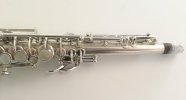No G# trill on my Holton C soprano. Of course it has forked Eb. Round pearl G# button. Teeny little palm keys very close to the body, but on individual sets of posts like modern palm keys. No front high F, though Holton Bb sopranos often have these.
Don't go trusting my judgement on intonation, I'm just reporting what I found myself.
Don't go trusting my judgement on intonation, I'm just reporting what I found myself.





